Abstract
The role of chlorinated primary effluents in viral pollution of the Ottawa River (Ontario) was assessed by examining 282 field samples of wastewaters from two different sewage treatment plants over a 2-year period. The talc-Celite technique was used for sample concentration, and BS-C-1 cells were employed for virus detection. Viruses were detected in 80% (75/94) of raw sewage, 72% (68/94) of primary effluent, and 56% (53/94) of chlorinated effluent samples. Both raw sewage and primary effluent samples contained about 100 viral infective units (VIU) per 100 ml. Chlorination produced a 10- to 50-fold reduction in VIU and gave nearly 2.7 VIU/100 ml of chlorinated primary effluent. With a combined daily chlorinated primary effluent output of approximately 3.7 × 108 liters, these two plants were discharging 1.0 × 1010 VIU per day. Because the river has a mean annual flow of 8.0 × 1010 liters per day, these two sources alone produced a virus loading of 1.0 VIU/8 liters of the river water. This river also receives at least 9.0 × 107 liters of raw sewage per day and undetermined but substantial amounts of storm waters and agricultural wastes. It is used for recreation and acts as a source of potable water for some 6.0 × 105 people. In view of the potential of water for disease transmission, discharge of such wastes into the water environment needs to be minimized.
Full text
PDF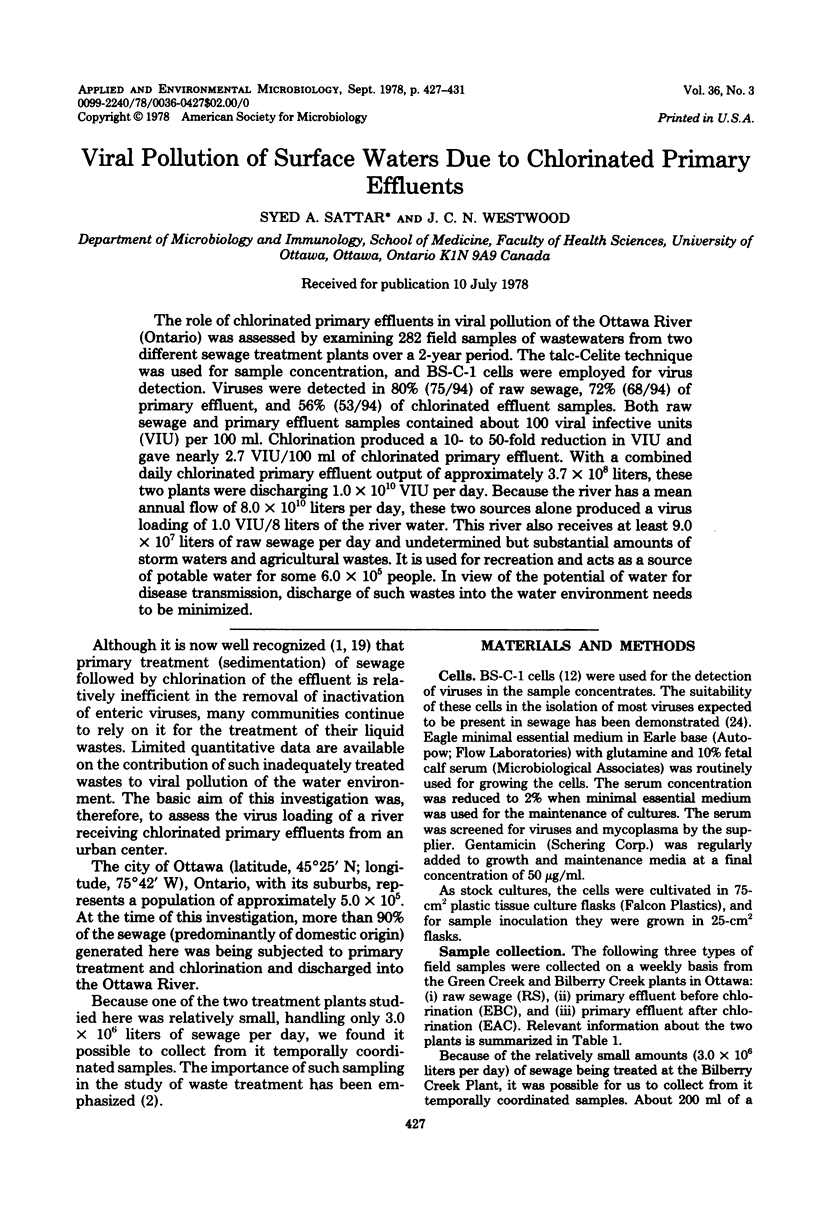
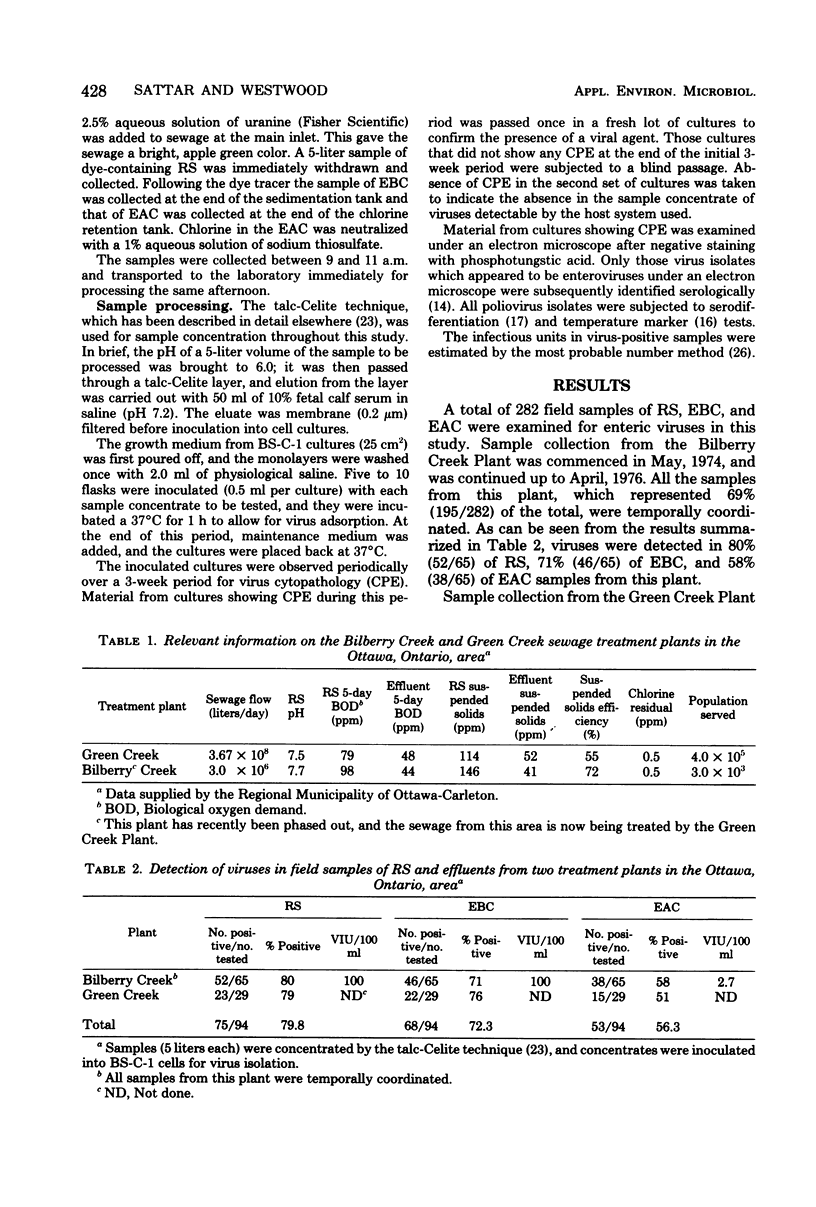
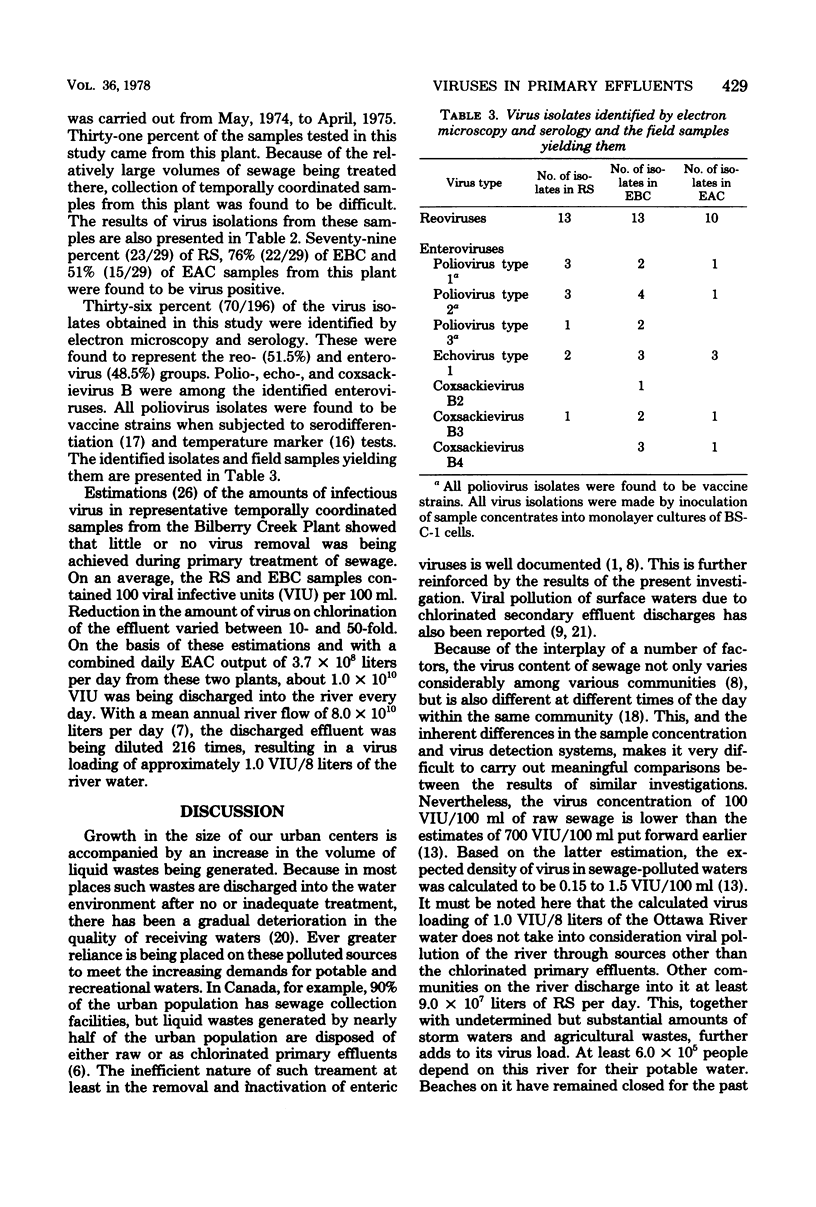
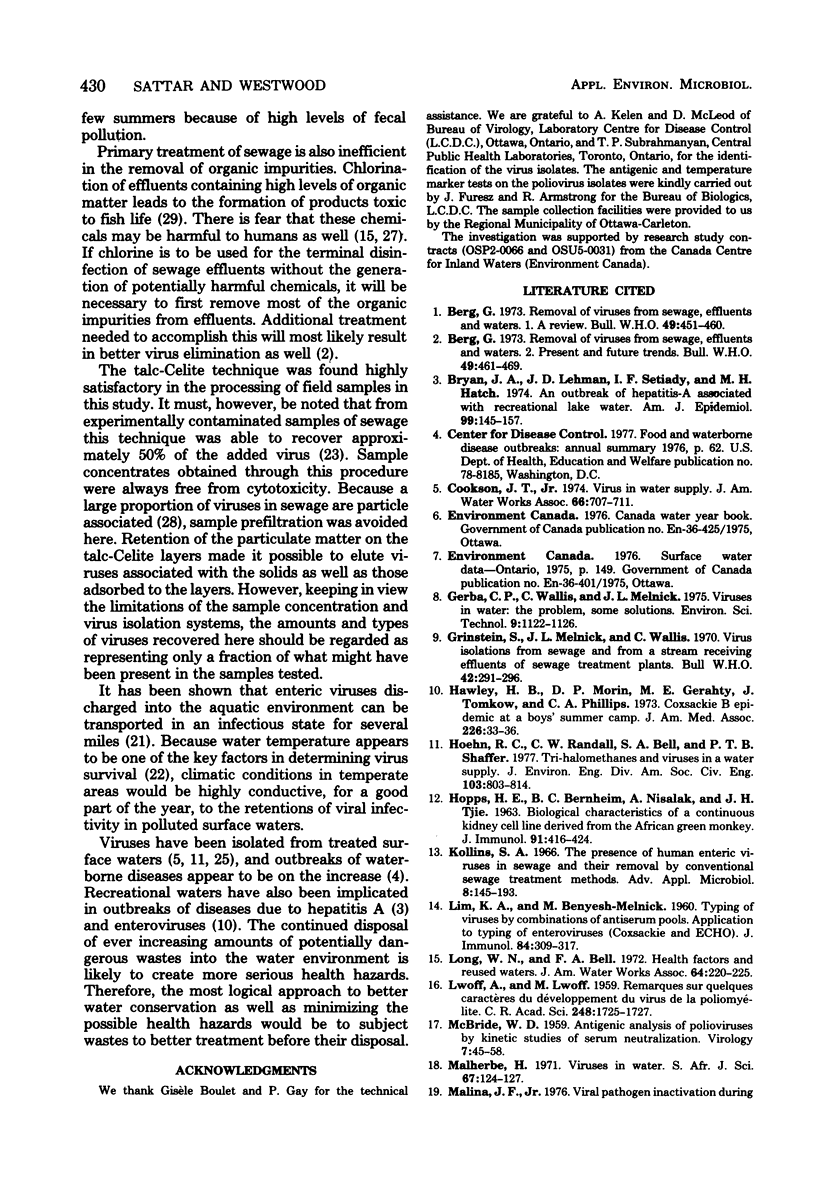
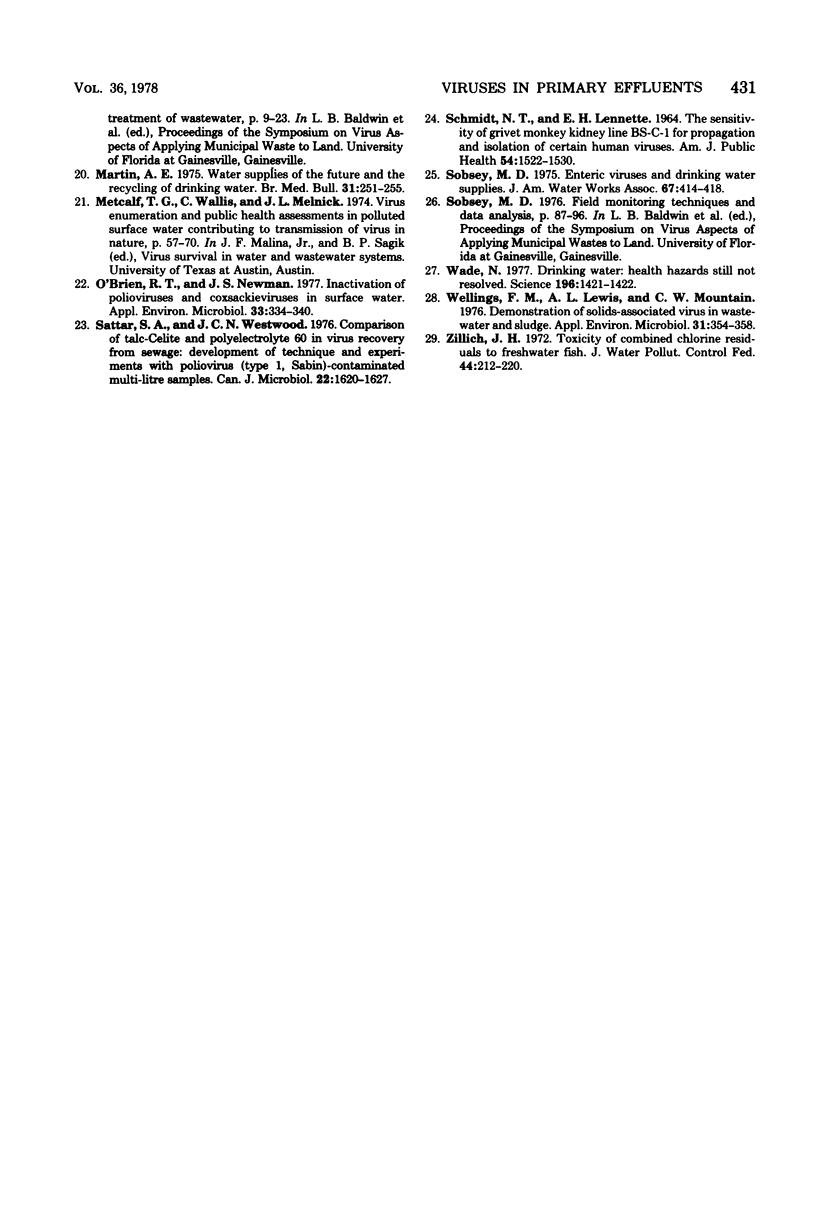
Selected References
These references are in PubMed. This may not be the complete list of references from this article.
- Berg G. Removal of viruses from sewage, effluents and waters. 2. Present and future trends. Bull World Health Organ. 1973;49(5):461–469. [PMC free article] [PubMed] [Google Scholar]
- Berg G. Removal of viruses from sewage, effluents, and waters. I. A review. Bull World Health Organ. 1973;49(5):451–460. [PMC free article] [PubMed] [Google Scholar]
- Bryan J. A., Lehmann J. D., Setiady I. F., Hatch M. H. An outbreak of hepatitis-A associated with recreational lake water. Am J Epidemiol. 1974 Feb;99(2):145–154. doi: 10.1093/oxfordjournals.aje.a121595. [DOI] [PubMed] [Google Scholar]
- Grinstein S., Melnick J. L., Wallis C. Virus isolations from sewage and from a stream receiving effluents of sewage treatment plants. Bull World Health Organ. 1970;42(2):291–296. [PMC free article] [PubMed] [Google Scholar]
- HOPPS H. E., BERNHEIM B. C., NISALAK A., TJIO J. H., SMADEL J. E. BIOLOGIC CHARACTERISTICS OF A CONTINUOUS KIDNEY CELL LINE DERIVED FROM THE AFRICAN GREEN MONKEY. J Immunol. 1963 Sep;91:416–424. [PubMed] [Google Scholar]
- Hawley H. B., Morin D. P., Geraghty M. E., Tomkow J., Phillips C. A. Coxsackievirus B epidemic at a Boy's Summer Camp. Isolation of virus from swimming water. JAMA. 1973 Oct 1;226(1):33–36. [PubMed] [Google Scholar]
- LIM K. A., BENYESH-MELNICK M. Typing of viruses by combinations of antiserum pools. Application to typing of enteroviruses (Coxsackie and ECHO). J Immunol. 1960 Mar;84:309–317. [PubMed] [Google Scholar]
- LWOFF A., LWOFF M. Remarques sur quelques caractères du développment du virus de la poliomyélite. C R Hebd Seances Acad Sci. 1959 Mar 16;248(11):1725–1727. [PubMed] [Google Scholar]
- Martin A. E. Water supplies of the future and the recycling of drinking-water. Br Med Bull. 1975 Sep;31(3):251–255. doi: 10.1093/oxfordjournals.bmb.a071295. [DOI] [PubMed] [Google Scholar]
- McBRIDE W. D. Antigenic analysis of polioviruses by kinetic studies of serum neutralization. Virology. 1959 Jan;7(1):45–58. doi: 10.1016/0042-6822(59)90176-x. [DOI] [PubMed] [Google Scholar]
- O'Brien R. T., Newman J. S. Inactivation of polioviruses and coxsackieviruses in surface water. Appl Environ Microbiol. 1977 Feb;33(2):334–340. doi: 10.1128/aem.33.2.334-340.1977. [DOI] [PMC free article] [PubMed] [Google Scholar]
- SCHMIDT N. J., LENNETTE E. H., SHON C. W., DENNIS J. THE SENSITIVITY OF GRIVET MONKEY KIDNEY CELL LINE BS-C-1 FOR PROPAGATION AND ISOLATION OF CERTAIN HUMAN VIRUSES. Am J Public Health Nations Health. 1964 Sep;54:1522–1530. doi: 10.2105/ajph.54.9.1522. [DOI] [PMC free article] [PubMed] [Google Scholar]
- Sattar S. A., Westwood J. C. Comparison of talc-Celite and polyelectrolyte 60 in virus recovery from sewage: development of technique and experiments with poliovirus (type 1, Sabin)-contaminated multilitre samples. Can J Microbiol. 1976 Nov;22(11):1620–1627. doi: 10.1139/m76-238. [DOI] [PubMed] [Google Scholar]
- Wade N. Drinking water: health hazards still not resolved. Science. 1977 Jun 24;196(4297):1421–1422. doi: 10.1126/science.196.4297.1421. [DOI] [PubMed] [Google Scholar]
- Wellings F. M., Lewis A. L., Mountain C. W. Demonstration of solids-associated virus in wastewater and sludge. Appl Environ Microbiol. 1976 Mar;31(3):354–358. doi: 10.1128/aem.31.3.354-358.1976. [DOI] [PMC free article] [PubMed] [Google Scholar]
- Zillich J. A. Toxicity of combined chlorine residuals to freshwater fish. J Water Pollut Control Fed. 1972 Feb;44(2):212–220. [PubMed] [Google Scholar]


